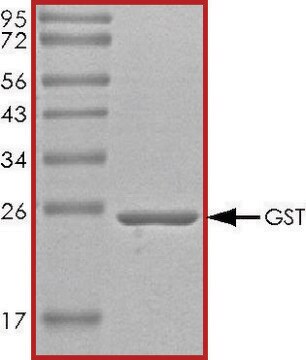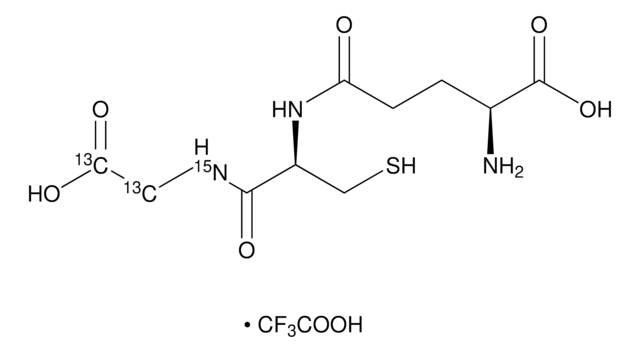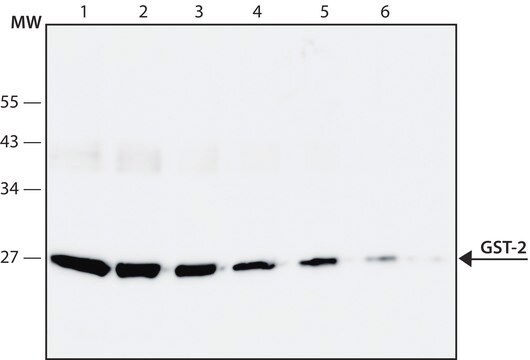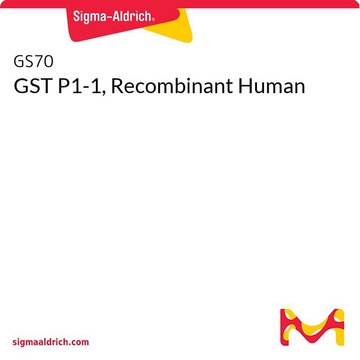G5663
Glutathione S-Transferase from E. coli
recombinant, expressed in E. coli, buffered aqueous solution
Sinonimo/i:
Glutathione S-alkenetransferase, Glutathione S-alkyltransferase, Glutathione S-aralkyltransferase, Glutathione S-aryltransferase, Glutathione S-epoxidetransferase, RX: Glutathione R-transferase
Autenticatiper visualizzare i prezzi riservati alla tua organizzazione & contrattuali
About This Item
Prodotti consigliati
Ricombinante
expressed in E. coli
Grado
Molecular Biology
for molecular biology
Stato
buffered aqueous solution
PM
26 kDa
Concentrazione
>0.1 mg/mL
>1 unit/mL
N° accesso UniProt
Condizioni di spedizione
wet ice
Temperatura di conservazione
2-8°C
Informazioni sul gene
human ... GSTM1(2944)
Descrizione generale
Glutathione S-transferase (GST) catalyzes the addition of the glutathione thiol group to a suitable electrophilic species. Enzymatic activities are based on the conjugation of reduced glutathione in the presence of a second substrate.
Specificità
Glutathione S-transferase (GST) catalyzes the addition of the glutathione thiol group to a suitable electrophilic species. Enzymatic activities are based on the conjugation of reduced glutathione in the presence of a
second substrate.
In ELISA, 0.5 μg of recombinant glutathione S-transferase is the minimum detectable level of enzyme with an anti-glutatione S-transferase, alkaline phosphatase conjugate.
In immunoblot, 50 ng of recombinant GST is the minimum detectable level of enzyme with an anti-glutathione S-transferase, alkaline phosphatase conjugate.
second substrate.
In ELISA, 0.5 μg of recombinant glutathione S-transferase is the minimum detectable level of enzyme with an anti-glutatione S-transferase, alkaline phosphatase conjugate.
In immunoblot, 50 ng of recombinant GST is the minimum detectable level of enzyme with an anti-glutathione S-transferase, alkaline phosphatase conjugate.
Applicazioni
Glutathione S-Transferase (GST) from E. coli has been used in the standard curve preparation for the quantification of GST-V5H6 produced by enzyme-linked immunosorbent assay (ELISA).
Suitable for use in ELISA and Western blot applications.
Azioni biochim/fisiol
Glutathione S-transferases (GST) catalyzes the conjugation of reduced glutathione with several substrates, which leads to detoxification. It also serves as transport proteins.
Attenzione
Due to the sodium azide content, consult the SDS for information regarding hazards and safe handling practices.
Definizione di unità
One unit will conjugate 1.0 micromole of 1-chloro-2,4-dinitrobenzene with reduced glutathione per minute at pH 6.5 at 25 deg C.
Stato fisico
GST is supplied as a solution in phosphate buffered saline containing 0.02% sodium azide. Every lot of material supplied will have 5 mg total enzyme, at a concentration greater than 0.1 mg/ml, typically 1.0 mg/ml.
Prodotti correlati
N° Catalogo
Descrizione
Determinazione del prezzo
Codice della classe di stoccaggio
12 - Non Combustible Liquids
Classe di pericolosità dell'acqua (WGK)
nwg
Punto d’infiammabilità (°F)
Not applicable
Punto d’infiammabilità (°C)
Not applicable
Scegli una delle versioni più recenti:
Possiedi già questo prodotto?
I documenti relativi ai prodotti acquistati recentemente sono disponibili nell’Archivio dei documenti.
I clienti hanno visto anche
Ji Qiu et al.
Methods in enzymology, 500, 151-163 (2011-09-29)
Systematic study of proteins requires the availability of thousands of proteins in functional format. However, traditional recombinant protein expression and purification methods have many drawbacks for such study at the proteome level. We have developed an innovative in situ protein
Living recombinant Saccharomyces cerevisiae secreting proteins or peptides as a new drug delivery system in the gut
Blanquet S, et al.
Journal of Biotechnology, 110(1), 37-49 (2004)
Single-step purification of polypeptides expressed in Escherichia coli as fusions with glutathione S-transferase
Smith D B and Johnson K S
Gene, 67(1), 31-40 (1988)
Clinical pathology in non-clinical toxicology testing
Haschek and Rousseaux's Handbook of Toxicologic Pathology, 565-594 (2013)
Niroshan Ramachandran et al.
Methods in molecular biology (Clifton, N.J.), 328, 1-14 (2006-06-21)
Protein microarrays are a miniaturized format for displaying in close spatial density hundreds or thousands of purified proteins that provide a powerful platform for the high-throughput assay of protein function. The traditional method of producing them requires the high-throughput production
Il team dei nostri ricercatori vanta grande esperienza in tutte le aree della ricerca quali Life Science, scienza dei materiali, sintesi chimica, cromatografia, discipline analitiche, ecc..
Contatta l'Assistenza Tecnica.






